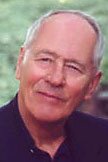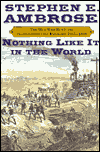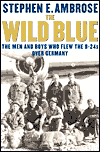
|
 |
Stephen Ambrose
 |
| Stephen Ambrose |
|
Dr. Stephen Ambrose is a renowned historian and acclaimed author of more than 30 books. Among his New York Times best-sellers are: Nothing Like It in the World, Citizen Soldiers, Band of Brothers, D-Day - June 6, 1944 , and Undaunted Courage . His latest projects, Wild Blue: The Men and Boys Who Flew the B-24's over Germany , is scheduled for release in the early fall. Also, he and his son Hugh are currently conducting research for a book on the World War IIs Pacific Theater, tentatively entitled Citizen Soldiers of the Pacific. |
 |
| Nothing Like It in the World: The Men Who Who Built the Transcontinental Railroad 1863-1869 |
| Hardcover |
Stephen Ambrose
|
|
In this account of an unprecedented feat of engineering, vision, and courage, Stephen E. Ambrose offers a historical successor to his universally acclaimed Undaunted Courage, which recounted the explorations of the West by Lewis and Clark.
Nothing Like It in the World is the story of the men who built the transcontinental railroad--the investors who risked their businesses and money; the enlightened politicians who understood its importance; the engineers and surveyors who risked, and lost, their lives; and the Irish and Chinese immigrants, the defeated Confederate soldiers, and the other laborers who did the backbreaking and dangerous work on the tracks.
The Union had won the Civil War and slavery had been abolished, but Abraham Lincoln, who was an early and constant champion of railroads, would not live to see the great achievement. In Ambrose's hands, this enterprise, with its huge expenditure of brainpower, muscle, and sweat, comes to life.
The U.S. government pitted two companies--the Union Pacific and the Central Pacific Railroads--against each other in a race for funding, encouraging speed over caution. Locomo-tives, rails, and spikes were shipped from the East through Panama or around South America to the West or lugged across the country to the Plains. This was the last great building project to be done mostly by hand: excavating dirt, cutting through ridges, filling gorges, blasting tunnels through mountains.
At its peak, the workforce--primarily Chinese on the Central Pacific, Irish on the Union Pacific--approached the size of Civil War armies, with as many as fifteen thousand workers on each line. The Union Pacific was led by Thomas "Doc" Durant, Oakes Ames, and Oliver Ames, with Grenville Dodge--America's greatest railroad builder--as chief engineer. The Central Pacific was led by California's "Big Four": Leland Stanford, Collis Huntington, Charles Crocker, and Mark Hopkins. The surveyors, the men who picked the route, were latter-day Lewis and Clark types who led the way through the wilderness, living off buffalo, deer, elk, and antelope.
In building a railroad, there is only one decisive spot--the end of the track. Nothing like this great work had been seen in the world when the last spike, a golden one, was driven in at Promontory Summit, Utah, in 1869, as the Central Pacific and the Union Pacific tracks were joined.
Ambrose writes with power and eloquence about the brave men--the famous and the unheralded, ordinary men doing the extraordinary--who accomplished the spectacular feat that made the continent into a nation.
|
|
|
Stephen E. Ambrose, one of the finest historians of our time, has written an unprecedented chronicle of U.S. involvement in World War II, geared toward young readers. Drawing from his best-selling books D-Day and Citizen Soldier, Ambrose captures the war's multitude of events in a running, cumulative narrative that will enlighten, and appeal to, young readers. From Japanese warplanes soaring over Pearl Harbor dropping devastation from the sky, the the Battle of the Buldge during the coldest winter in Europe's modern history, to the against-all-odds Allied victory at Midway, to the tormenting decision to bomb Nagasaki and Hiroshima with atomic weapons, The Good Fight brings the most horrific, and most heroic, war in history to a new generation in a way that's never been done before.
Each spread in The Good Fight highlights a specific conflict with spectacular color and black-and-white photographs. Ambrose's narrative is further highlighted with factual side-bars, maps, a glossary, a bilbliography, an index, and a listing of related Web sites. Spreads are also devoted to the Holocaust, D-Day, and the conditions in Asia and Europe that provoked the war. Stephen E. Ambrose's singular ability to take complex and multifaceted information and get right to its essence makes this book not only a teacher's dream, but a mesmerizing read. This is the book for World War II for kids.
|
|
 |
| Wild Blue: The Men and Boys Who Flew the B-24s Over Germany, The |
| Hardcover |
Stephen Ambrose
|
|
Stephen Ambrose is the acknowledged dean of the historians of World War II in Europe. In three highly acclaimed, bestselling volumes, he has told the story of the bravery, steadfastness, and ingenuity of the ordinary young men, the citizen soldiers, who fought the enemy to a standstill--the band of brothers who endured together.
The very young men who flew the B-24s over Germany in World War II against terrible odds were yet another exceptional band of brothers, and, in The Wild Blue, Ambrose recounts their extraordinary brand of heroism, skill, daring, and comradeship with the same vivid detail and affection.
Ambrose describes how the Army Air Forces recruited, trained, and then chose those few who would undertake the most demanding and dangerous jobs in the war. These are the boys--turned pilots, bombardiers, navigators, and gunners of the B-24s--who suffered over 50 percent casualties.
With his remarkable gift for bringing alive the action and tension of combat, Ambrose carries us along in the crowded, uncomfortable, and dangerous B-24s as their crews fought to the death through thick black smoke and deadly flak to reach their targets and destroy the German war machine. Twenty-two-year-old George McGovern, who was to become a United States senator and a presidential candidate, flew thirty-five combat missions (all the Army would allow) and won the Distinguished Flying Cross. We meet him and his mates, his co-pilot killed in action, and crews of other planes. Many went down in flames.
As Band of Brothers and Citizen Soldiers portrayed the bravery and ultimate victory of the American soldiers from Normandy on to Germany, The Wild Blue makes clear the contribution these young men of the Army Air Forces stationed in Italy made to the Allied victory.
|
|
|


